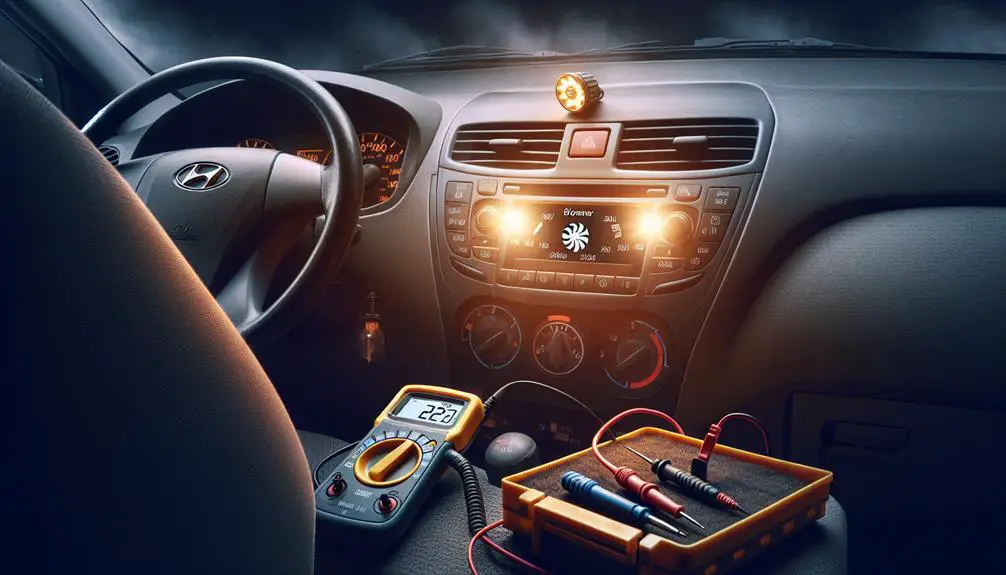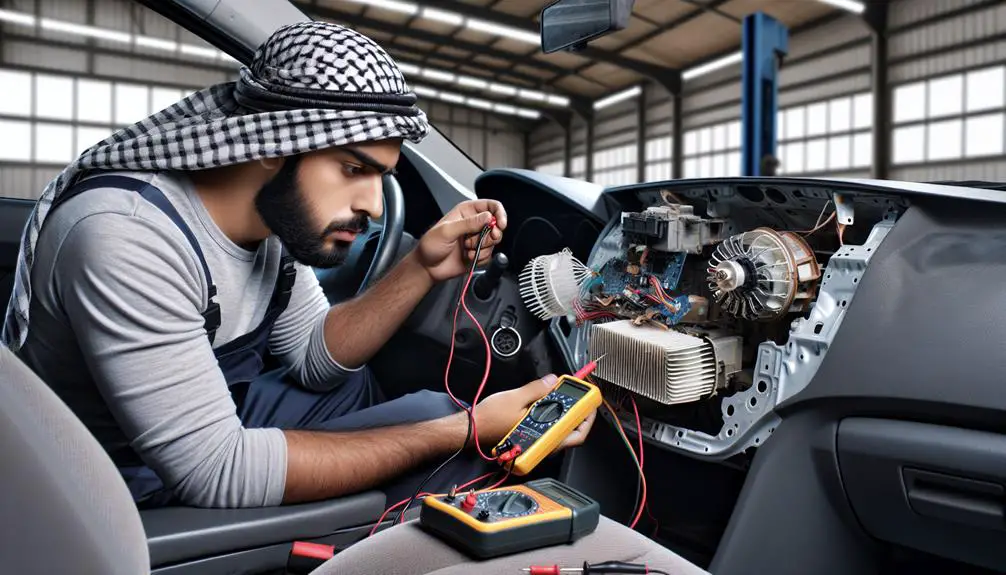- Check the fuse for the blower motor in the Hyundai Trajet.
- Test the blower motor to determine if it is functioning properly.
- If the fuse is intact and the motor is working, the issue might lie with the blower motor resistor or the HVAC control module.
- Consult the vehicle's manual or a professional mechanic for further diagnosis and repair.
Identifying the Problem

To identify the issue with your Hyundai Trajet's blower motor, start by observing any irregularities in air flow or strange noises when the system is running. You might notice that the air isn't blowing as strongly as it used to or it's not blowing at all. Sometimes, you'll hear a rattling or buzzing sound, which can indicate a problem with the motor itself or debris caught in the blower unit.
Next, check if the issue persists across all settings. If the air flow is weak or non-existent only at certain speeds, it's a sign that your blower motor resistor might be failing. However, since we're focusing on the motor itself, if the problem is consistent across all settings, it's more likely the motor.
It's worth paying attention to the smell. A burning odor can suggest the motor is overheating and may be on its way out. This is a serious issue and you'll want to address it quickly to avoid further damage to your vehicle's HVAC system.
Checking the Fuse
Before diving deeper into the motor issue, it's important you check the fuse associated with your Hyundai Trajet's blower system.
A blown fuse is often the simplest reason your blower motor isn't working. The fuse box in your Hyundai Trajet is typically located under the dashboard, on the driver's side. You'll need the manual to pinpoint the exact location and identify the specific fuse linked to the blower motor.
Once you've found the right fuse, carefully remove it. You're looking for any signs of damage or breakage in the metal wire inside the fuse. If it's broken or appears burnt, the fuse has blown. This is a good sign in the sense that it's an easy fix. All you need to do is replace it with a new fuse of the same amperage. It's important you use a fuse with the identical rating to avoid any electrical issues. After replacing it, turn on your vehicle and check if the blower motor operates.
If the fuse looks intact, don't rule it out completely. Sometimes, damages aren't visible to the naked eye. It's wise to test it with a multimeter for continuity. If the multimeter shows no continuity, the fuse, important appearing fine, needs replacing.
Inspecting the Resistor

After checking the fuse and finding no issues, it's time to inspect the resistor linked to your Hyundai Trajet's blower motor. This component is important as it controls the speed of the blower motor by varying the electrical resistance sent to the motor. A faulty resistor can cause the blower motor to stop working or only work at one speed.
Initially, you'll need to locate the resistor. It's typically found mounted to the HVAC unit, accessible from under the glove compartment or near the blower motor itself. Once located, you'll want to disconnect the electrical connector and remove any screws or fasteners holding the resistor in place.
Visually inspect the resistor for signs of damage, such as corrosion, overheating, or physical wear. These signs can indicate that the resistor has failed and needs replacement. However, visual inspection alone may not always reveal the problem.
For a more thorough check, you'll need a multimeter to test the resistor's functionality. Set your multimeter to the resistance measurement mode and check each of the resistor's terminals. You're looking for continuity or specific resistance values according to your Hyundai Trajet's service manual. If you find infinite resistance or no continuity across any of the terminals, the resistor is faulty and needs replacing.
Testing the Blower Motor
Once you've inspected the resistor, the next step is testing your Hyundai Trajet's blower motor to make sure it's functioning correctly.
First, you'll need to locate the blower motor. It's usually found under the dashboard on the passenger side. Before you start, make sure your car's engine is off and the key is removed from the ignition. Safety first!
Next, disconnect the electrical connector from the blower motor. You'll need a multimeter set to the ohms (resistance) setting for the next part. Connect the multimeter's leads to the terminals on the blower motor. A functioning blower motor should show some resistance. If the multimeter displays 'OL' (over limit), it indicates there's no continuity, and the blower motor is likely faulty.
If your multimeter shows resistance, the next step is to check if the motor can actually turn. You can do this by manually spinning the blower fan. If it spins freely without any unusual noises or resistance, that's a good sign. However, if it's hard to turn or makes grinding sounds, the motor might be seized or damaged.
For a more thorough test, you can apply direct power to the blower motor. Using jumper wires, connect the motor directly to the battery—positive to positive and negative to negative. If the motor doesn't operate under direct power, it's confirmed to be the problem.
Professional Diagnosis and Repair

If you're unsure about your Hyundai Trajet's blower motor diagnosis, it's best to consult a professional mechanic for accurate troubleshooting and repair. A professional can offer a thorough diagnosis, ensuring that the root cause of the blower motor not working is precisely identified. This step is important because sometimes the issue mightn't be with the blower motor itself but with related components, such as the resistor, fuses, or wiring.
When you take your car to a mechanic, they'll likely start with a visual inspection, followed by electrical testing to check the voltage and ground at the blower motor. If the motor is receiving power but isn't operating, it's a clear sign that the motor needs replacement. However, if there's no power, the problem could lie elsewhere in the circuit.
A professional mechanic has the advantage of specialized tools and knowledge to perform tests that aren't easily done at home. For instance, they might use a scan tool to check for any fault codes related to the HVAC system, which can provide valuable insights into the problem.
Additionally, a professional repair ensures that the job is done right the first time, with the correct parts and procedures. They can also warranty their work, giving you peace of mind that if something goes wrong, you're covered.
Conclusion
You've gone through the steps to troubleshoot your Hyundai Trajet's blower motor issue.
You've checked the fuse, inspected the resistor, and tested the blower motor itself.
If none of these steps solved the problem, it's time to seek professional help.
A qualified technician can diagnose and repair your system efficiently, ensuring you get back to enjoying a comfortable cabin temperature.
Don't hesitate to reach out to a professional for a reliable fix.